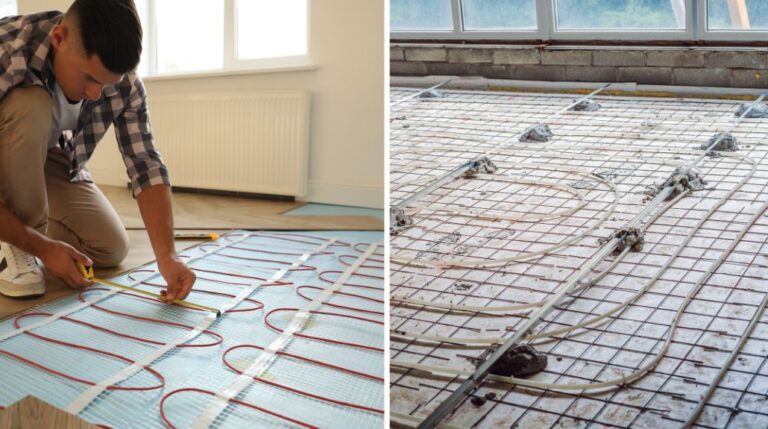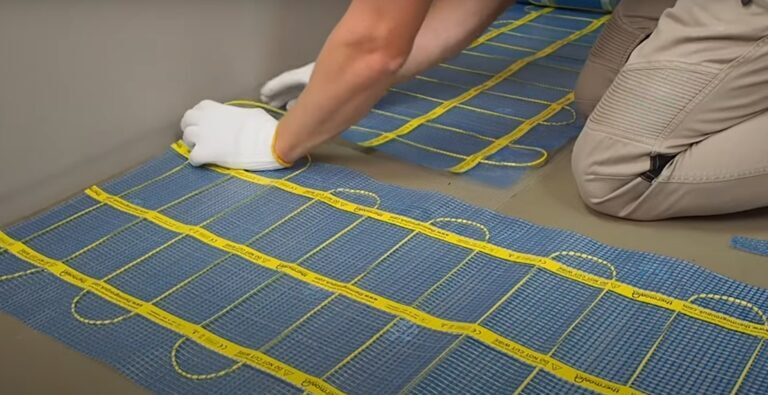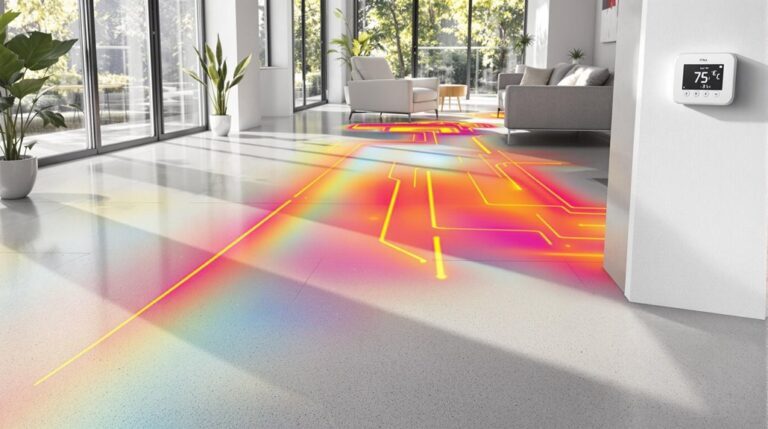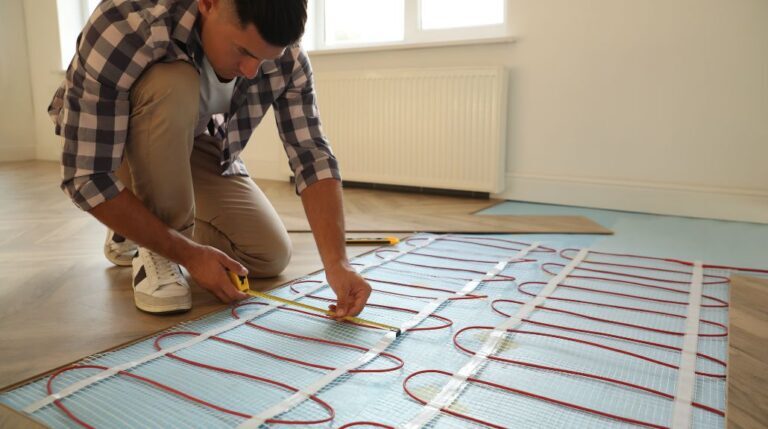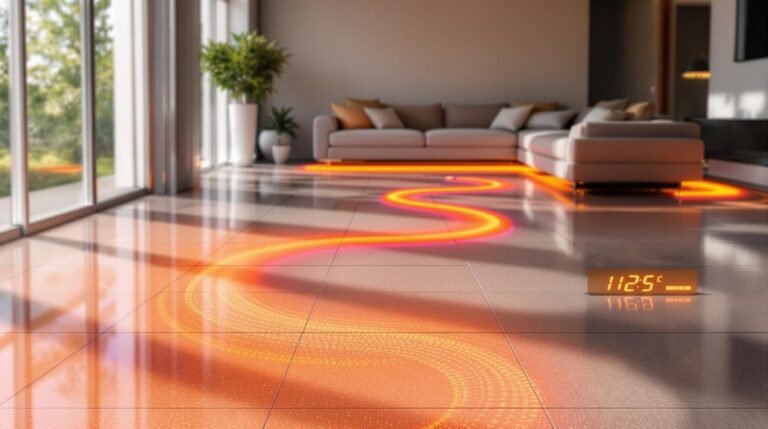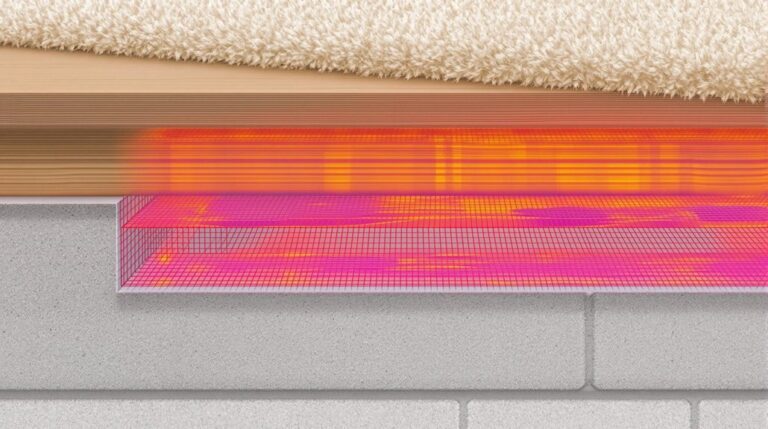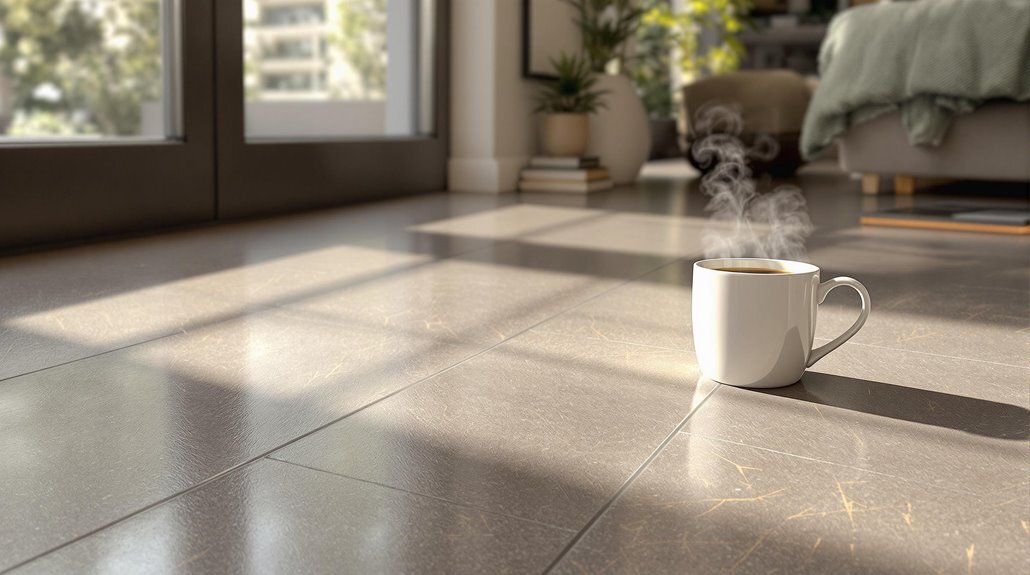
When you’re planning to install underfloor heating, your choice of flooring material can make or break the system’s efficiency. You’ll want to select materials that conduct and distribute heat effectively while maintaining their structural integrity under varying temperatures. While you might’ve heard conflicting advice about which options work best, several proven flooring types can enhance your heating system’s performance. From traditional ceramic tiles to modern engineered wood solutions, each material offers distinct advantages – and potential drawbacks – that’ll influence both your comfort and energy costs.
Key Takeaways
- Tiles and natural stone provide excellent thermal conductivity, making them ideal choices for underfloor heating systems.
- Engineered wood flooring with 14-16mm thickness offers efficient heat transfer and can heat rooms 25% faster than radiators.
- Luxury Vinyl Tile (LVT) works well with underfloor heating while maintaining temperatures below 27°C for optimal performance.
- Carpets can be used if total tog rating (carpet plus underlay) remains below 2.5 to ensure effective heat transfer.
- Polished concrete offers high thermal mass properties, while thin laminate flooring ensures quick and efficient heat distribution.
Understanding Underfloor Heating Systems
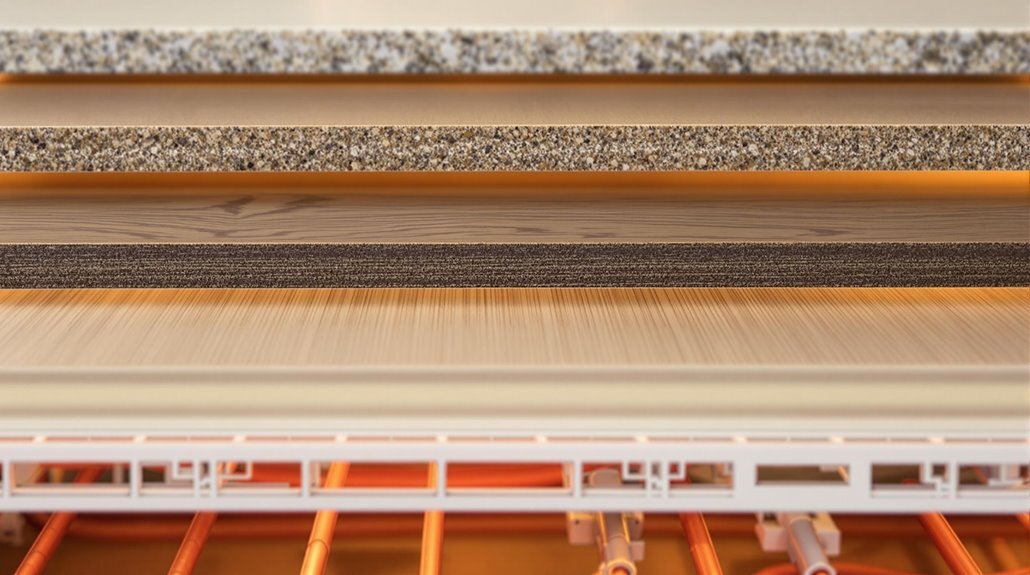
While many homeowners dream of warm, cozy floors during Sydney’s chilly winters, they often don’t understand how underfloor heating actually works. At Floor Heating Today, we regularly explain that underfloor heating systems distribute warmth through pipes beneath your flooring, operating at temperatures between 25°C – 28°C, which is lower than traditional radiators.
When considering what flooring is suitable for underfloor heating, it’s essential to understand the system’s components. The setup includes thermostats, control packs, manifolds, and pipe circuits that work together to maintain consistent temperatures.
You’ll find two main types of systems: electric heating mats with embedded cables and warm water systems using flexible polyethylene pipes.
The key to maximizing flooring for underfloor heating lies in thermal resistance and heat transfer properties. Your system’s energy efficiency depends heavily on proper insulation, which prevents heat loss and directs warmth upward into your living space.
The insulation layer is particularly important as it guarantees the heat doesn’t escape downward, making your system up to 40% more efficient than traditional heating methods.
You can control different zones of your home independently through intelligent thermostats, allowing for precise temperature management. This zoning capability means you’re not wasting energy heating unused areas.
Whether you’re using a gas boiler, heat pump, or solar heating panels as your heat source, the system distributes warmth evenly throughout your space, eliminating cold spots and creating a comfortable environment without visible radiators.
Best Flooring Materials
Now that you understand how underfloor heating works, let’s look at your flooring options.
When it comes to suitable for underfloor heating materials, you’ll find that some perform notably better than others regarding heat conductivity.
Engineered flooring is one of your best choices, particularly when it’s glued down. We’ve found that thinner planks work more efficiently with underfloor heating systems, though you’ll need to avoid certain wood species like Beech and hard Maple due to their expansion properties.
Keep in mind that surface temperatures shouldn’t exceed 27°C to protect your wood flooring.
Luxury Vinyl Tile (LVT) and microcement are excellent options that offer superior heat transfer. LVT’s thermal properties make it highly efficient, while microcement’s thin profile guarantees rapid, even heating.
If you’re contemplating carpet, stick to low-tog options, as thick carpets can greatly reduce heat efficiency.
For a modern finish, you might want to think about polished screed or synthetic resins. These materials work exceptionally well with underfloor heating due to their excellent thermal properties.
Linoleum and PVC flooring are also compatible choices that can provide both style and functionality.
Tile and Stone Options
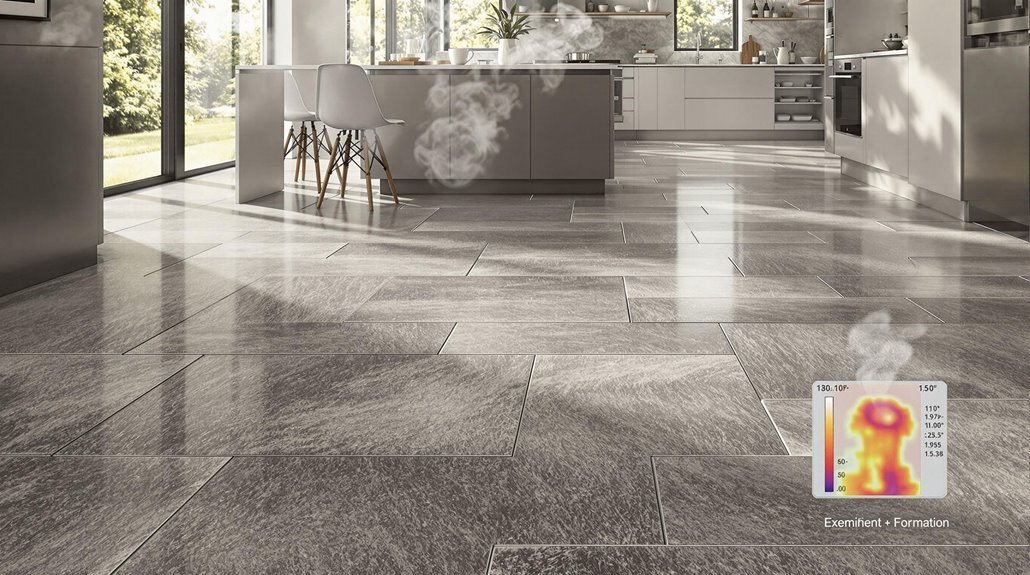
Having installed underfloor heating systems across Sydney for over a decade, I can confidently say that tiles and natural stone are among the most popular flooring choices.
These materials offer exceptional thermal conductivity, making them ideal partners for underfloor heating systems. When you choose ceramic, porcelain, or natural stone flooring, you’re selecting materials that efficiently transfer and retain heat, guaranteeing your space stays consistently warm.
The beauty of tiles and stone lies in their practical benefits for underfloor heating installations. They heat up quickly and can reach temperatures above 84°F, providing rapid warmth when you need it.
Their durability makes them perfect for high-traffic areas, and they’re remarkably easy to maintain. You’ll find that these materials work effectively with both electric and hydronic heating systems, though proper installation is essential for peak performance.
Here are the key considerations when selecting tiles or stone for your heated floor:
- Material thickness: Keep it under 3/4″ for the most responsive heating
- Adhesive selection: Use flexible, two-part adhesive to accommodate thermal movement
- Installation method: Confirm proper insulation and professional electrical work
When you’re planning your underfloor heating project, remember that different types of stone and tiles offer varying levels of thermal conductivity.
Porcelain and ceramic tiles typically provide the best heat transfer, while natural stones like marble and slate offer unique aesthetic appeal while maintaining good heating efficiency.
For the best results, we recommend professional installation to guarantee your system performs at its best for years to come.
Working With Engineered Wood
Many of our Sydney clients ask about engineered wood as an alternative to tiles and stone, and for good reason. At Floor Heating Today, we’ve found that engineered floor options offer excellent thermal conductivity while providing the warm, natural appeal of wood flooring.
When properly installed, engineered wood can heat your room 25% faster than traditional radiator systems.
You’ll want to choose boards that are 14-16mm thick, with a 3-4mm real wood layer. This ideal thickness guarantees efficient heat transfer while maintaining structural stability. Oak and Walnut are particularly effective choices, as they offer superior heat distribution and retention.
We recommend keeping board widths around 150mm for the best heating performance.
When installing engineered wood with underfloor heating, you’ll need to pay close attention to moisture content. The layered construction of engineered flooring allows for controlled expansion and contraction, but proper subfloor preparation is essential.
You can install the flooring directly over your heating system using either a floating floor method or a batten system, and we recommend using low-tog underlays for additional support when installing over screed.
The efficiency benefits are significant – you can expect up to 30% better efficiency compared to traditional radiators when using a boiler, and over 40% when paired with renewable energy sources.
Just remember to avoid boards thicker than 18mm, as they can act as insulators and reduce your system’s effectiveness.
Regular maintenance is straightforward – simply sweep or vacuum regularly and follow the manufacturer’s cleaning guidelines to keep your floor in prime condition.
Benefits of Laminate Floors
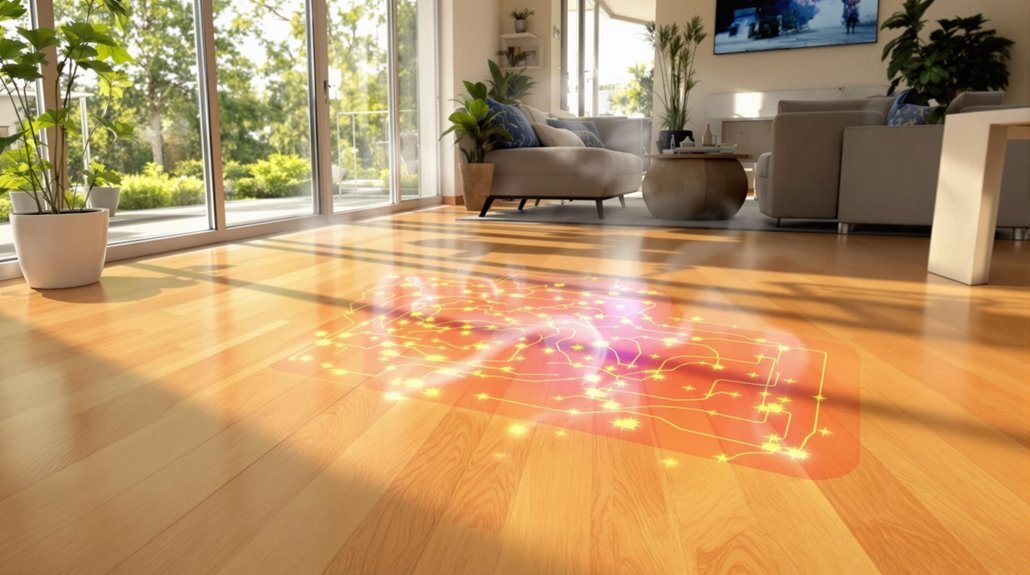
For decades, we’ve installed laminate flooring with underfloor heating systems across Sydney homes, and its popularity continues to grow. The combination delivers exceptional comfort and energy efficiency, making it an ideal choice for modern Australian homes.
Laminate flooring’s thin profile and excellent thermal conductivity guarantee quick heat transfer, helping you maintain consistent warmth while keeping energy costs down.
What makes laminate flooring particularly appealing is its remarkable durability and easy maintenance. The tough external layer and resin coating protect against scratches, impacts, and stains, offering a lifespan of 15-30 years with proper care.
You’ll appreciate how simple it’s to keep clean – just regular sweeping and occasional mopping will maintain its beautiful appearance without requiring special treatments or varnishes.
Here are the key benefits you’ll enjoy when combining laminate flooring with underfloor heating:
- Enhanced energy efficiency through superior heat distribution and minimal heat loss
- Quick and easy installation with click-and-lock systems, reducing installation costs
- Extensive style options that mimic hardwood or stone while providing better heating performance
The environmental benefits are equally impressive. Your laminate flooring choice supports sustainability as it’s made from wood by-products without harvesting endangered trees.
It’s also hypoallergenic, keeping your home free from trapped dust and allergens. When paired with underfloor heating, you’re creating a comfortable, efficient, and environmentally conscious living space that will serve you well for years to come.
Vinyl Flooring Performance
Vinyl flooring powerhouses like Luxury Vinyl Tiles (LVT) and sheet vinyl deliver exceptional performance when paired with underfloor heating systems. Their thermal conductivity allows for efficient heat distribution throughout your space, making them an excellent choice for Australian homes seeking comfort and efficiency.
Here’s a quick comparison of vinyl flooring performance characteristics:
| Feature | Performance Rating |
|---|---|
| Heat Transfer | Excellent – Quick heat-up times |
| Durability | High – Resistant to daily wear |
| Maintenance | Simple – Regular sweeping/mopping |
| Energy Efficiency | Superior – Low heat resistance |
When it comes to installation considerations, you’ll want to verify your vinyl flooring is properly acclimated to your home’s environment before installation. At Floor Heating Today, we recommend keeping the surface temperature below 27°C to prevent any potential damage to your flooring investment.
The performance of vinyl flooring with underfloor heating largely depends on proper installation and maintenance. You’ll need a clean, level subfloor, preferably concrete or screed, to achieve ideal results. Avoid using thick underlays as they can reduce the system’s efficiency and impact heat distribution.
Remember that different types of vinyl flooring offer varying levels of performance. While LVT and sheet vinyl are top performers, vinyl plank flooring can also work well when installed correctly. The key is selecting the right thickness and material composition to verify your underfloor heating system operates at peak efficiency.
Carpet Considerations
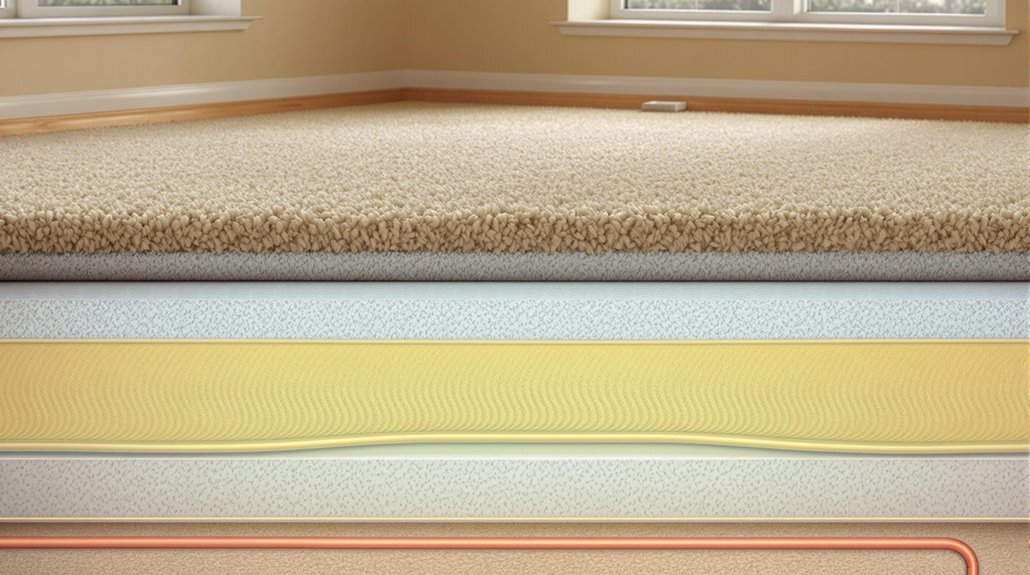
Selecting the right carpet for your underfloor heating system requires careful consideration of both material and thickness. The key factor to watch is the tog rating – a measure of thermal resistance. For peak performance, your carpet and underlay’s combined tog value shouldn’t exceed 2.5. This guarantees efficient heat transfer from your heating system to your room.
When choosing carpets, hessian-backed options work best with underfloor heating due to their low thermal resistance. Standard 80% wool and 20% nylon mix carpets, with a tog rating of around 1.23, are excellent choices. However, you’ll want to avoid carpets with rubber backing or those using felt underlays, as these materials create thermal barriers that reduce your system’s efficiency.
Your underlay choice is equally important. Look for specially designed underlays with tog ratings between 0.5-0.6, such as Technics 5 and 6. These products allow heat to pass through while still providing the comfort and support you need.
Here are three essential points to remember when selecting carpet for underfloor heating:
- Always check the combined tog rating of your carpet and underlay – keep it under 2.5
- Choose hessian-backed carpets over rubber-backed options
- Select thin, dense underlays specifically designed for underfloor heating systems
Remember to maintain your floor temperature below 27°C using a thermostat, and maintain proper subfloor insulation for maximum efficiency.
If you’re unsure about your carpet’s compatibility, don’t hesitate to contact us at Floor Heating Today for professional advice.
Alternative Flooring Choices
Many homeowners seek alternatives to carpet when installing underfloor heating, and with good reason. At Floor Heating Today, we’ve found that certain flooring materials perform exceptionally well with underfloor heating systems, offering superior thermal conductivity and comfort.
Tile and stone flooring stands out as a top performer, with excellent heat conductivity and the ability to maintain temperatures up to 29°C. These materials store heat effectively, creating an efficient heating solution for your home. If you’re considering wooden flooring, we recommend engineered wood with a dense, thin structure. It’s best installed using a glue-down method to guarantee ideal heat transfer, particularly with hydronic systems.
Vinyl and laminate flooring offers another practical solution, providing good thermal conductivity while being thin and responsive. Remember to keep vinyl temperatures below 27°C for best results. Here’s a quick comparison of popular flooring options:
| Material Type | Heat Conductivity | Max Temperature |
|---|---|---|
| Tile/Stone | Excellent | 29°C |
| Vinyl/Laminate | Good | 27°C |
| Engineered Wood | Moderate | 27°C |
For those interested in alternative options, polished concrete works exceptionally well due to its thermal mass, while PVC floors offer reliable performance. However, avoid certain wood species like Beech and hard Maple, as they’re prone to excessive expansion and contraction. Whatever your choice, we’ll help guarantee your flooring works effectively with your underfloor heating system.
Installation and Cost Factors
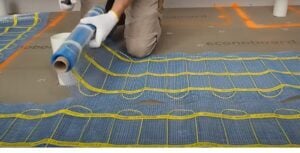
The successful installation of underfloor heating involves three critical factors: proper subfloor preparation, professional installation, and cost management.
At Floor Heating Today, we’ve found that achieving ideal efficiency starts with making sure your subfloor is dry, smooth, and dust-free. You’ll need to apply a leveling compound if necessary and install proper insulation to maximize heat retention.
When it comes to costs, you’re looking at two main system types. Electric systems typically range from $19,000 to $36,000, while hydronic systems can cost between $19,000 and $48,000. Your material costs will vary depending on your choice – electric mats cost $5 to $8 per square foot, while hydronic tubing runs $0.80 to $1.25 per square foot.
Labor costs usually range from $550 to $2,500, depending on your location in Sydney and surrounding areas.
- Essential Installation Steps:
- Prepare subfloor and install perimeter strips
- Layout heating cables or mats according to specifications
- Connect system to thermostat (must be done by licensed electrician)
While initial costs might seem significant, proper installation guarantees long-term efficiency and comfort.
Hydronic systems, though more expensive upfront, typically cost less to operate over time as water retains heat longer than electric systems.
Remember that your location can affect the total cost due to transportation expenses for both materials and labor. We recommend factoring in these variables when planning your underfloor heating project to avoid unexpected expenses.


